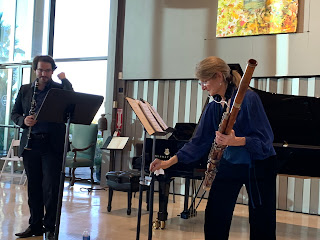 |
| The Thies Consort: l-r Jennifer Johnson Cullinan, Judith Farmer, Robert Thies, Laura Brenes, Sérgio Coelho. |
REVIEW
The Thies Consort, South Bay Chamber Music Society, Pacific Unitarian Church, Rancho Palos Verdes
DAVID J BROWN
 |
| Robert Thies. |
So far as is known, Mozart was the first composer to write for the combination of piano, oboe, clarinet, bassoon, and horn, and though it’s not certain whether Beethoven heard his work, or saw Mozart’s manuscript, the fact that his own quintet for this same, and still exceedingly rare, combination of instruments is in the same key and follows the same structural ground-plan argues strongly for some awareness on Beethoven’s part of its predecessor.
 |
| Mozart in 1782, painted by Joseph Lange. |
This is apparent from the very first measures. Mozart begins Largo with serene, widely separated woodwind chords supported by the piano, between which the piano alone muses on a seven-note figure, subtly altered each time. He then reverses the texture, so that the winds take over the seven-note figure. Beethoven, on the other hand (but at a similar Grave tempo), launches a dotted, downwards-stepping statement from all five instruments. Though marked piano, the effect is of quiet, assertive strength, intimating challenge and drama to come.
 |
| The young Beethoven. |
This was a rare opportunity to “compare and contrast” side-by-side two apparently very similar but in fact strongly differing works, and it would be difficult to imagine performances that better demonstrated the qualities of each than those by the Thies Consort (Robert Thies, piano; Jennifer Johnson Cullinan, oboe; Sérgio Coelho, clarinet; Judith Farmer, bassoon; Laura Brenes, horn).
 |
| Gernot Wolfgang and Judith Farmer. |
This witty, jazz-inflected work lasts no longer than 10 minutes, and the insouciant inconsequentiality with which short phrases, and even single notes and pauses, were tossed back and forth between the players (Sérgio Coelho, clarinet, and Judith Farmer, bassoon) more than once raised amused and appreciative murmurs from the audience. To characterize its three brief movements one can do no better than to quote the composer directly, from an earlier program note:
 |
| Sérgio Coelho and Judith Farmer Passing Through. |
"Bounce refers to the bass line in 7/8 played by the bassoon at the beginning of the first movement. Evening Song resides within a tranquil, peaceful atmosphere. The Flea comments on the jumpiness and, at times, unpredictability of the third movement.”
---ooo---
South Bay Chamber Music Society, LA Harbor College/ Pacific Unitarian Church, Friday/Sunday, 18/20 November, 2022.
Images: The performers: author; Robert Thies: artist website; Gernot Wolfgang: composer website; Mozart and Beethoven: Wikimedia Commons.
If you found this review to be useful, interesting, or informative, please feel free to Buy Me A Coffee!













No comments:
Post a Comment